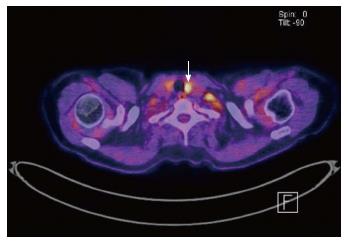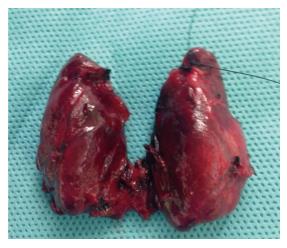Published online Dec 16, 2017. doi: 10.12998/wjcc.v5.i12.437
Peer-review started: May 17, 2017
First decision: July 5, 2017
Revised: November 3, 2017
Accepted: November 10, 2017
Article in press: November 10, 2017
Published online: December 16, 2017
Processing time: 206 Days and 20 Hours
A healthy woman volunteered to participate as “healthy control” in a study. An increased level of procalcitonin (PCT) was detected and remained elevated on follow-up measurements. As calcitonin levels were elevated as well, thyroid ultrasound was performed which revealed nodes in both thyroid lobes, one of them showing metabolic activity in positron emission tomography-computed tomography scan. To exclude a malignant thyroid cancer despite the negative findings in a fine needle aspiration the patient underwent thyroidectomy and a medullary thyroid carcinoma (MTC) was detected in the right lobe. MTC is a rare endocrine tumor with a poor prognosis once having spread, therefore early detection remains a priority for the outcome. Screening parameter is serum calcitonin, in absence of infection the pro-hormone PCT can be used as a screening parameter as well with high sensitivity.
Core tip: A lady participating as healthy control in a study was found to suffer from a medullary thyroid cancer, a type of cancer in total surgical removal before the tumor has spread is the most important prognostic factor. The difficulty is the low diagnostic accuracy of ultrasound and procalcitonin-computed tomography scan, as well as the limitations of fine needle aspiration in a patient with several nodules. This case illustrates the consequences of volunteering as a “healthy control” in a clinical study. While early detection of the MCT was possible in our patient it paid off for her, but abnormal test results may also cause harm to patients if being false positive and leading to invasive procedures.
- Citation: Giessen H, Nebiker CA, Bruehlmeier M, Spreitzer S, Mueller B, Schuetz P. Do you want to participate in a clinical study as a healthy control? - Risk or benefit? World J Clin Cases 2017; 5(12): 437-439
- URL: https://www.wjgnet.com/2307-8960/full/v5/i12/437.htm
- DOI: https://dx.doi.org/10.12998/wjcc.v5.i12.437
In our hospital a study to validate the accuracy of a new assay of procalcitonin (PCT) was conducted and a healthy woman working in our hospital was willing to participate in this study as a healthy control.
PCT is excreted by parenchymatous organs in the presence of bacterial infection. As precursor of calcitonin it is elevated in medullary thyroid cancer (MTC) as well as calcitonin. Frozen serum calcitonin can be used as screening parameter, but several non-specialized laboratories limit the use of calcitonin in MTC[1].
A 57-year-old, previously healthy woman working in the Department of Clinical Pathology of our hospital volunteered to participate as “healthy control” in a study to validate the accuracy of a new PCT assay. She reported to be in good general health condition without signs of ongoing infection or disease. The patient did not smoke or consume large amounts of alcohol and had no signs of malignancy on physical examination or routine blood analysis. Yet, a markedly increased level of circulating PCT of 0.35 μg/L (normal range < 0.03 μg/L) was detected, which remained elevated on follow-up measurements for the next 2 mo.
Subsequently, calcitonin levels were found to be elevated as well (33 ng/L, normal range < 5 ng/L). A thyroid ultrasound revealed a goiter with small nodules in both thyroid lobes. There were two suspicious thyroid nodules, a small one lateral in the right thyroid lobe (7 mm × 5 mm × 6 mm) and a larger one (10 mm × 10 mm × 13 mm) in the left lobe. A fine needle aspiration (FNA) of the bigger node on the left side was done but neither reveal any malignant cells nor was it positive for calcitonin staining, making the existence of a MTC unlikely. To exclude a gastrointestinal neuroendocrine tumor or a small cell lung cancer, both of which have been reported to ectopically produce PCT as well, we decided to perform a 18F-FDG positron emission tomography-computed tomography (PET-CT), in which the left thyroid nodule detected on ultrasound showed an increased 18F-FDG uptake. There were no other suspicious lesions in the whole body PET-CT scan (Figure 1).
A previously healthy woman willing to support a scientific study was found to have an elevated level of PCT and calcitonin, a goiter, 2 suspicious nodes in the sonography of the thyroid gland with one of them showing metabolic activity in PET-CT scan.
The case was discussed at our internal tumor board, which recommended total thyroidectomy to exclude MTC despite the negative fine needle aspiration as no other cause of elevations in calcitonin and PCT could be found (Figure 2).
The patient agreed to have surgery which went without complications. The histological evaluation of the thyroid gland showed an (incidental) 3 mm papillary microcarcinoma in the left lobe and a 6 mm medullary carcinoma in the right lobe, inconsistent with the active nodule in the left thyroid lobe in PET-CT. No further neck dissection was done due to the relatively low preoperative calcitonin levels.
Two weeks after surgery the patient came back to the endocrine office. Her PCT and calcitonin levels were now undetectable. We recommended close clinical and biochemical monitoring over the next years. Her prognosis is favorable due to the early recognition of the medullary cancer with small tumor volume, in total resection and no signs of metastasis.
This case has three key teaching points relevant for clinical care. First, MTC is a rare endocrine tumor accounting for 8% of all thyroid carcinomas[2]. With a five year mortality rate of 50%-70% it represents 14% of all thyroid gland related deaths. Early detection and in total surgical removal before the tumor has spread are the most important prognostic factors to lower mortality in this type of cancer. Due to the poor prognosis of medullary cancer once it has spread, early detection remains a priority[2]. Current guidelines are ambiguous regarding general screening for MTC with calcitonin in the work-up of thyroid nodules, whereas opponents argue it may not be cost-effective[1,3,4]. The challenge in our patient with incidental MTC is the low diagnostic accuracy of ultrasound and the PET-CT scan. In our patient, neither test correctly identified or localized the cancer, as retrospectively the metabolically active nodule did not turn out to be malignant. Additionally, fine needle aspiration has limitations particularly sampling bias in a patient with several nodules.
Second, the precursor of calcitonin, PCT became more recently known as an ubiquitously produced biomarker of inflammation and infection. As such it can be used evidence-based in clinical routine guide to diagnosis and antibiotic therapy in respiratory infections and sepsis[5].
As an endocrine tumor marker in the absence of an infection, an elevated ratio of the procalcitonin to calcitonin indicates worse prognosis in patients suffering from MTC[6,7].
Last but not least incidental findings of clinical exams, check-ups, laboratory exams and imaging often occur during diagnostic work-up. This case illustrates possible consequences of volunteering as a “healthy control” in a clinical study. While it most certainly paid off for our patient, abnormal test results may also cause harm to patients if being false positive and leading to invasive procedures. In conclusion, it may become important to discuss risks and benefits when “simply” asking a person to volunteer for a clinical study - even if as an allegedly “healthy control”.
Medullary thyroid cancer is a rare cancer that can present with an increased circumference of the throat or a change in voice but is mostly asymptomatic.
Most medullary carcinoma (MCT) occur sporadic, but in 20% a hereditary pattern (multiple endocrine neoplasia type 2, men 2) is present, a mutation of the RET protooncogene can be found.
MTC is likely to spread lymphogenic to paratracheal and lateral cervical lymph nodes or hematogenous in liver, lungs and bones.
The only curative treatment is the total thyroidectomie with removal of all affected tissue in the neck.
Systemic chemotherapy with dacarbazine, 5-fluoruracil or doxorubicin has shown a poor response in only 10%-20%.
Regular measurements of serum calcitonin as tumor marker is used and remission is demonstrated by undetectable serum calcitonin.
Manuscript source: Unsolicited manuscript
Specialty type: Medicine, research and experimental
Country of origin: Switzerland
Peer-review report classification
Grade A (Excellent): 0
Grade B (Very good): 0
Grade C (Good): C, C
Grade D (Fair): 0
Grade E (Poor): 0
P- Reviewer: Jiang B, Lakhdar F S- Editor: Ji FF L- Editor: A E- Editor: Lu YJ
| 1. | Kaczka K, Mikosiński S, Fendler W, Jałocha-Kaczka A, Pomorski L. Can procalcitonin be useful for medullary thyroid cancer? Endokrynol Pol. 2010;61:430-436. [PubMed] |
| 2. | Leboulleux S, Baudin E, Travagli JP, Schlumberger M. Medullary thyroid carcinoma. Clin Endocrinol (Oxf). 2004;61:299-310. [RCA] [PubMed] [DOI] [Full Text] [Cited by in Crossref: 224] [Cited by in RCA: 205] [Article Influence: 9.8] [Reference Citation Analysis (0)] |
| 3. | Trimboli P, Seregni E, Treglia G, Alevizaki M, Giovanella L. Procalcitonin for detecting medullary thyroid carcinoma: a systematic review. Endocr Relat Cancer. 2015;22:R157-R164. [RCA] [PubMed] [DOI] [Full Text] [Cited by in Crossref: 44] [Cited by in RCA: 44] [Article Influence: 4.4] [Reference Citation Analysis (0)] |
| 4. | Giovanella L, Verburg FA, Imperiali M, Valabrega S, Trimboli P, Ceriani L. Comparison of serum calcitonin and procalcitonin in detecting medullary thyroid carcinoma among patients with thyroid nodules. Clin Chem Lab Med. 2013;51:1477-1481. [RCA] [PubMed] [DOI] [Full Text] [Cited by in Crossref: 20] [Cited by in RCA: 29] [Article Influence: 2.6] [Reference Citation Analysis (0)] |
| 5. | Schuetz P, Wirz Y, Sager R, Christ-Crain M, Stolz D, Tamm M, Bouadma L, Luyt CE, Wolff M, Chastre J. Effect of procalcitonin-guided antibiotic treatment on mortality in acute respiratory infections: a patient level meta-analysis. Lancet Infect Dis. 2017; Epub ahead of print. [RCA] [PubMed] [DOI] [Full Text] [Cited by in Crossref: 243] [Cited by in RCA: 335] [Article Influence: 41.9] [Reference Citation Analysis (0)] |
| 6. | Machens A, Lorenz K, Dralle H. Utility of serum procalcitonin for screening and risk stratification of medullary thyroid cancer. J Clin Endocrinol Metab. 2014;99:2986-2994. [RCA] [PubMed] [DOI] [Full Text] [Cited by in Crossref: 59] [Cited by in RCA: 49] [Article Influence: 4.5] [Reference Citation Analysis (0)] |
| 7. | Walter MA, Meier C, Radimerski T, Iten F, Kränzlin M, Müller-Brand J, de Groot JW, Kema IP, Links TP, Müller B. Procalcitonin levels predict clinical course and progression-free survival in patients with medullary thyroid cancer. Cancer. 2010;116:31-40. [RCA] [PubMed] [DOI] [Full Text] [Cited by in Crossref: 7] [Cited by in RCA: 19] [Article Influence: 1.3] [Reference Citation Analysis (0)] |














